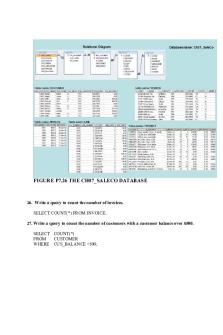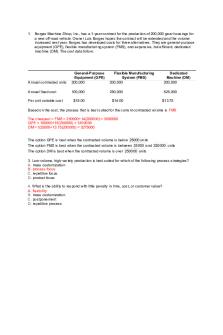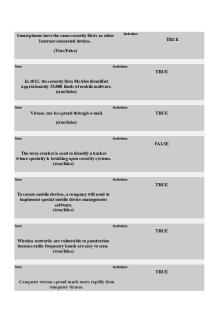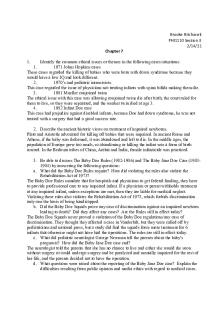CH7 Non Experimental Research PDF

| Title | CH7 Non Experimental Research |
|---|---|
| Author | Kaitlyn Oliveri |
| Course | Introduction To Research Methods And Data Analysis |
| Institution | California State University Monterey Bay |
| Pages | 3 |
| File Size | 161.2 KB |
| File Type | |
| Total Downloads | 76 |
| Total Views | 162 |
Summary
Justin Matthews
Explains non-experimental research and how it is performed...
Description
Chapter 7: Non Experimental Research Nonexperimental Research: - Reserach that LACKS the manipulation of an independent varibale or the random assignment of participants to conditions or orders of conditions - Experimental research can provide strong evidence that changes in an IV cause differences in a DV, nonexperimental research generally CANNOT → This does not mean that nonexperimental research is less important than experimental research or inferior to it any general sense - When to Manipulate: - Manipulate the IV when… it is possible, feasible, and ethical - Random Assignment when.. Participants to conditions orders of conditions - If a researcher cannot manipulate the IV or they cannot use random assignment in some fashion → Use nonexperimental research - Use both nonexperimental research (first) and experimental research (second) overtime Types of NonExperimental Research: - Single-Variable Research: Research that focuses on a single variable rather than on a statistical relationship between vaiables - Example → Miligram Obedience Study - Correlational Research: Research in which two or more variables are measueed and the statistical realtionship among them are assessed. There is no manipulated independent variable and usually very little attempt to control extraneous variables *MAJOR MISCONCEPTION → DOES NOT NEED TO INVOLVE TWO QUANTITATIVE VARIABLES) - They may be interested in just assessing the statistical relationship between two variables, because they don’t believe there is a casual element to the relationship - Example → New vs. Old BDI Scale (Results should be the same or similar if measuring the same concept even if using different questions) - While a research may think there is a casual relationship between two variables, but the researcher is not able to manipulate one of th variables for some reason - Example → If you focus on daily hassles in relation to physical/ psychological symptoms, it would be difficult to manipualte daily hassles - Three common types of data collection methods in correlational research - Naturalistic Observation: An approach to data collection in which the behavior of interste is observed in the environment in which it typically occurs. - Make your observation as unobstructive as possible so that participants are often not aware that they are being studied - Ethically, this is considered to be acceptable if the participants remain anonymous and the behavior occurs in a public setting where people would not normally have an expectation of privacy - Example: Observing shoppers in a a grocery store or observing children on a school playground - Coding: An approach to measurement in naturalistic observation, in which target behaviors are specified ahead of time and observers watch for and record those specific behaviors - Archival Data: Existing data that were collected or created for some other purpose. They can include school/ hospital records, newspaper/ magazine articles, internet content, tv shows, and many others - Content Analysis: A family of techniques for analyzing archival data that generally
-
involves identifying specfic words, phrases, ideas, or other content in the data and then counting or summarizing their occurence in other quanititatve ways Quasi-Experimental Research: Research that involves the manipulation of an indepdendent variable but lacks the random assignment of participants to conditions or orders of conditions. It is genrally used in field settings to test the effectiveness of a treatment - Since the independent variable is manipulated before the dependent variable is measued, quasi-experimental research eliminates the directionality problem - However since the participants are not randomly assigned, this does not eliminate the problem of confounding variables - Three Common Types of Quasi-Experimental Design - Nonequivalent Groups Design: Between-subjects research design in which participants are not randomly assigned to conditions, usually because participants are in preexisting groups - Example → If two classes are running an experiment on fraction exams, there are other confounding variables that influence the result like teaching style, etc. - Pretest-Posttest Design (*Similar to a within-subjects design, but no counterbalancing): Research design in which the dependent variable is measure (the pretest), a treatment is given, and the dependent is measured again (the posttest) to see if there is a change in the dependent variable from pretest to posttest
-
-
Methods of Treatment: - History: Refers collectively to extraneous events that can occur between a pretes and posttest or between the first and last measurements in a time series - Can provide an alternative explanation for an observed change in the dependent variable - Maturation: Refers collectively to extraneous developmental changes in participants that can occur between a pretest and posttest or between the first and last measuremetns in a time series - Can provide an alternative explanation for an observed change in the dependent variable - Regression to the Mean: The statistical fact that an individual who scores extremely on one occassion will tend to score less extremely on the next occasion - Spontaneous Remission: Improvement in a psychological or medical problem over time without any treatment Interrupted Time Series Design: A research design in which a series of measurements of the dependent variable are taken both before and after a treatment - Similar to pretest-posttest design but manny pretests and posttests
General Forms of Data Collection: - Qualitative Research: Research that typically involves formulation broad research questions, collecting large amounts of data froma small number of participants, and summarizig the data using nonstatistical techniques. The data are usually nonnumerical and are analyzed using non-statistical
-
-
techniques - Originated in the discipline of anthropology and socioloy but is now used to study psychology - Researcher are less concerned with drawing general conclusions than wtih understanding in detail the experience of their research participants - Can help generate general interesting research questions - Can help with providing detailed descriptions or communicating the behavior of particular groups in certain situations - Examples of Qualitative Data Collection: - Interviews: These can be structured, semistructured, or unstructured depending on how well specified the sequence of questions or prompts is - Focus Groups: Small group of people who participate together in an interview focused on a particular topic or issue - Participant Observation: An approach to data collection in qualitiative research in which the researcher becomes an active participant in the group or situation under study - Grounded Theory: An approach to analyzing qualitative data in which repeating ideas are identified and grouped into broader themes that are integreated in a theoretical narrative - Theoretical Narrative: A narrative interpretation of the broad themes that emerge from the data, usually supported by many direction quotations or examples from the data Quantitative Research: Research that involves formulating focused research questions, collecting small amounts of data from a large number of participants, and summarizing the data using descriptive and inferential statistics - Not good at general interesting research questions - Not good at providing detailed descriptions or communicating the behavior of particular groups in certain situations - Some quantitative researchers criticize qualitative methods on the ground that they lack objectivity, are difficult to evaluate for reliabiltiy/ validity, and do not allow generalization to people or situations other than those actually studies Mixed Method Research: Reserach that uses both quantitative and qualitative methods - Triangulation: In mixed methods research, using multiple quantitative and qualitiative methods to study the same topic, with the goal of converging on a single interpretation
Internal Validity Revisited:
-
Recall that internal validity is the extent to which the desing of a study supports the conclusion that changes in the independent variable caused any observed differences in the dependent variable - Correlational: Problems of Directionality and Third Variable - Quasi-Experimental: Use in Manipulation and Avoid in Random Assignment - Experimental: Adresses Directionality/ Third Variable by Using Manipulation/ Random Assignment...
Similar Free PDFs

CH7 Non Experimental Research
- 3 Pages

EXPERIMENTAL RESEARCH - metolit
- 2 Pages

Ch7 - Ch7
- 11 Pages

Ch7
- 4 Pages

Experimental
- 33 Pages

Testbank ch7
- 4 Pages

PHI1110 CH7
- 3 Pages

Práctica experimental
- 4 Pages

Experimental Psychology
- 2 Pages

Informe Experimental
- 14 Pages
Popular Institutions
- Tinajero National High School - Annex
- Politeknik Caltex Riau
- Yokohama City University
- SGT University
- University of Al-Qadisiyah
- Divine Word College of Vigan
- Techniek College Rotterdam
- Universidade de Santiago
- Universiti Teknologi MARA Cawangan Johor Kampus Pasir Gudang
- Poltekkes Kemenkes Yogyakarta
- Baguio City National High School
- Colegio san marcos
- preparatoria uno
- Centro de Bachillerato Tecnológico Industrial y de Servicios No. 107
- Dalian Maritime University
- Quang Trung Secondary School
- Colegio Tecnológico en Informática
- Corporación Regional de Educación Superior
- Grupo CEDVA
- Dar Al Uloom University
- Centro de Estudios Preuniversitarios de la Universidad Nacional de Ingeniería
- 上智大学
- Aakash International School, Nuna Majara
- San Felipe Neri Catholic School
- Kang Chiao International School - New Taipei City
- Misamis Occidental National High School
- Institución Educativa Escuela Normal Juan Ladrilleros
- Kolehiyo ng Pantukan
- Batanes State College
- Instituto Continental
- Sekolah Menengah Kejuruan Kesehatan Kaltara (Tarakan)
- Colegio de La Inmaculada Concepcion - Cebu





